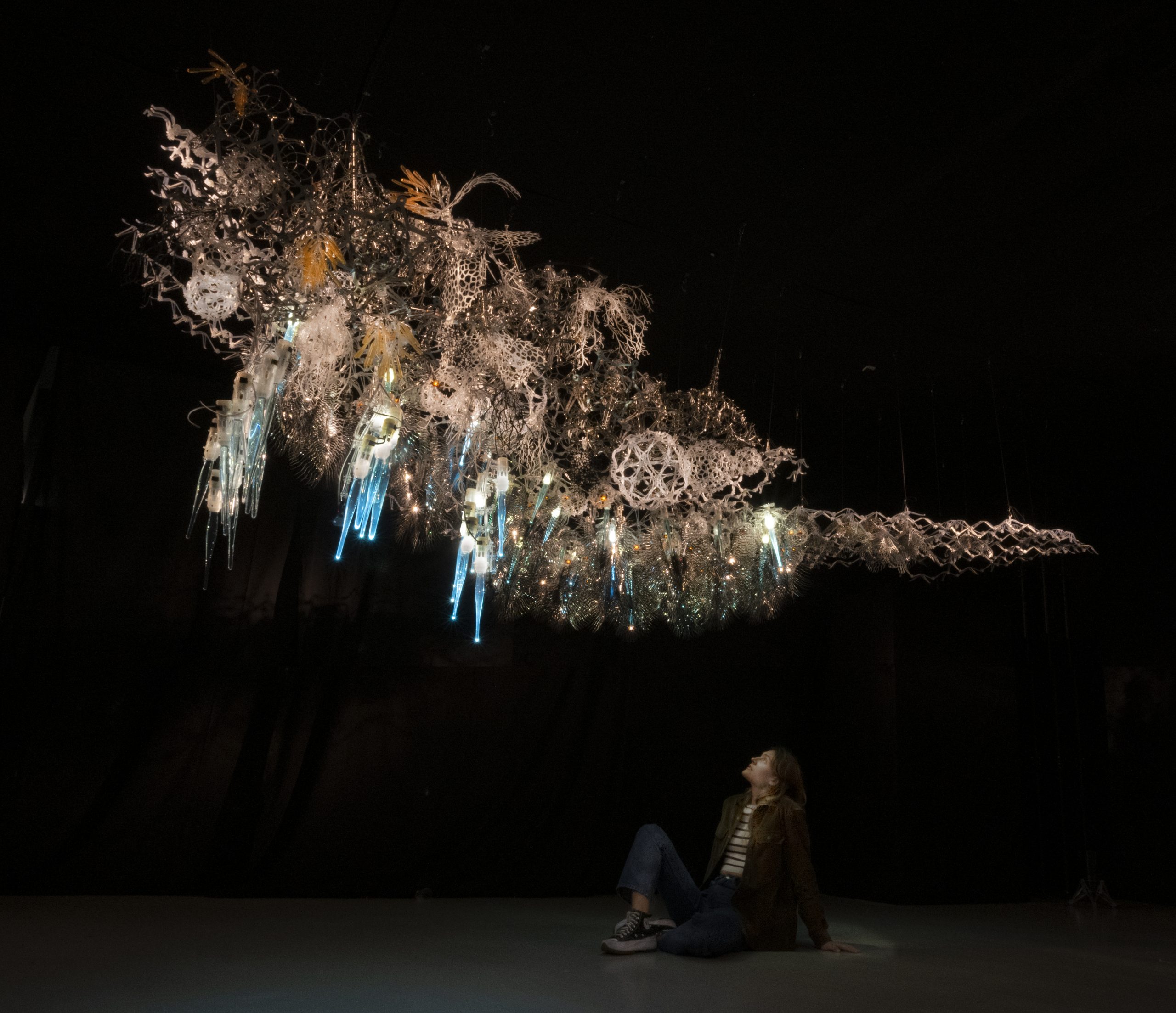
How can we design kinetic, living architecture that engages with visitors during extended interactions and enhances human experience in an immersive environment?
How do humans respond to these evolving interactions, in a process of mutual adaptation?“
Can architecture integrate living functions? Could future buildings think, and care? The Living Architecture Systems Group brings together researchers and industry partners in a multidisciplinary research cluster dedicated to developing built environments with qualities that come close to life— environments that can move, respond, and learn, with metabolisms that can exchange and renew their environments, and which are adaptive and empathic towards their inhabitants.”
A new Living Architecture testbed will be installed at the entry of the new TU Delft Science Centre. This site provides strategic connections to the campus and city right in the centre of a larger cluster of experimental architectural structures featuring next-generation construction, alternate energy sources and sustainable material systems. The project will act as a public beacon that gathers the public and that expresses a sustainable, inclusive vision of future design. A part of the installation facilitates evolving student design explorations and additional workshop-based activities.
Poietic Veil is a Living Architecture Prototype Testbed for TU Delft developed by Living Architecture Systems Group and Philip Beesley of Waterloo Architecture in collaboration with TU Delft Science Centre.
Living Architecture testbed, could future buildings think, and care?
About Philip Beesley
Philip Beesley's work is widely cited in contemporary art and architecture, focused in the rapidly expanding technology and culture of responsive and interactive systems. His art, architecture and research focus on key questions: might future architecture integrate living functions? Might buildings start to think, and care?
Beesley is a practicing visual artist, architect, and Professor in Architecture at the University of Waterloo and Professor of Digital Design and Architecture & Urbanism at the European Graduate School. He is the leader of the 40-partner Living Architecture Systems Group and the director of Riverside Architectural Press. He combines the disciplines of professional architecture, science, engineering, and visual art. His studio's methods incorporate industrial design, digital prototyping, instrument making, and mechatronics engineering. He served the recurring role of Examiner at The Bartlett, University College London and as visiting professor at schools including the Royal Danish Academy, University of Toronto Daniels School of Architecture, Landscape and Design, Pratt Institute for Architecture.
Beesley has authored and edited eighteen books and proceedings, and has appeared on the cover of Artificial Life (MIT), LEONARDO and AD journals. Features include national CBC news, Vogue, WIRED, and a series of TED talks. His work was selected to represent Canada at the 2010 Venice Biennale for Architecture, and has received distinctions including the Prix de Rome, VIDA 11.0, FEIDAD, Azure AZ, and Architizer A+. He shared this year’s STARTS EU prize for Iris van Herpen’sMagnetic Motion. His work has twice been recognized as a finalist for the global Katerva sustainability award. Beesley was educated in visual art at Queen's University, in technology at Humber College, in architecture at the University of Toronto, and interned in instrument making and lighting design His Toronto-based practice, Philip Beesley Architect Inc., operates in partnership with Rolf Seifert and the Waterloo-based Adaptive Systems Group, and in numerous collaborations including longstanding exchanges with couture designer Iris van Herpen futurist Rachel Armstrong. PBAI/PS, and engineering scientists Dala Kulic and Rob Gorbet.
www.philipbeesleystudioinc.com / www.livingarchitecturesystems.com
Thanks to
Supported by: Social Sciences and Humanities Research Council of Canada, Canada Council for the Arts, Delft University of Technology, University of Waterloo, Art on Campus, Philip Beesley Studio Inc., Gorbet Design Inc
Credits:
Project Leads: Philip Beesley, Timothy Boll, Matt Gorbet, Lisa Jiang, Michael Lancaster
LASG Executive: Rob Gorbet, Anne Paxton, Rekha Ramachandran, Alison Thompson
LASG Design & Production: Adrian Chîu, Kevan Cress, Nicolas Desilles, Mike Nopper
TUDelft Interactive Environments Minor Students: Ada Fabrykiewicz, Benjamin van Schaik, Diana Lore De la Vega Valdés, Eli Hommes, François Andrés, Ha Yeun Kim, Ian Lin, Izzy Mico, Jafet Koeckhoven, Jeroen Heijmans, Joris Mooij, Julia Kleinwächter, Laura Arango Mejia, Laura Martinez Quesada, Leonor Falcão, Linjing Wu, Nika Umnov, Doruk Kırbeyi, Olaf Kamperman, Pablo Yániz González, Rita J. Gorriz Salanova, Sasha Kiselev, Sophie Timmerman, Stijn Gruben, Tasmin Whittle, Tieme van Wijnen, Tijmen Tonino
TUDelft Interactive Environments Minor Staff: Aadjan van der Helm, Wim Schermer, Martin Havranek, Govert Schilling, Dieter Vandoren, Justin Oosterbaan, Caspar Krijgsman, Vivian Nguyen, Nathan Douenburg, Doreen Mulder, Adriaan Bernstein
TUDelft Science Centre Staff: Angela Hanna, Teun Verkerk, Jules Dudok, Michael van der Meer, Max Mahieu
4DSOUND: Poul Holleman, Joris Takken, Roman Willems
